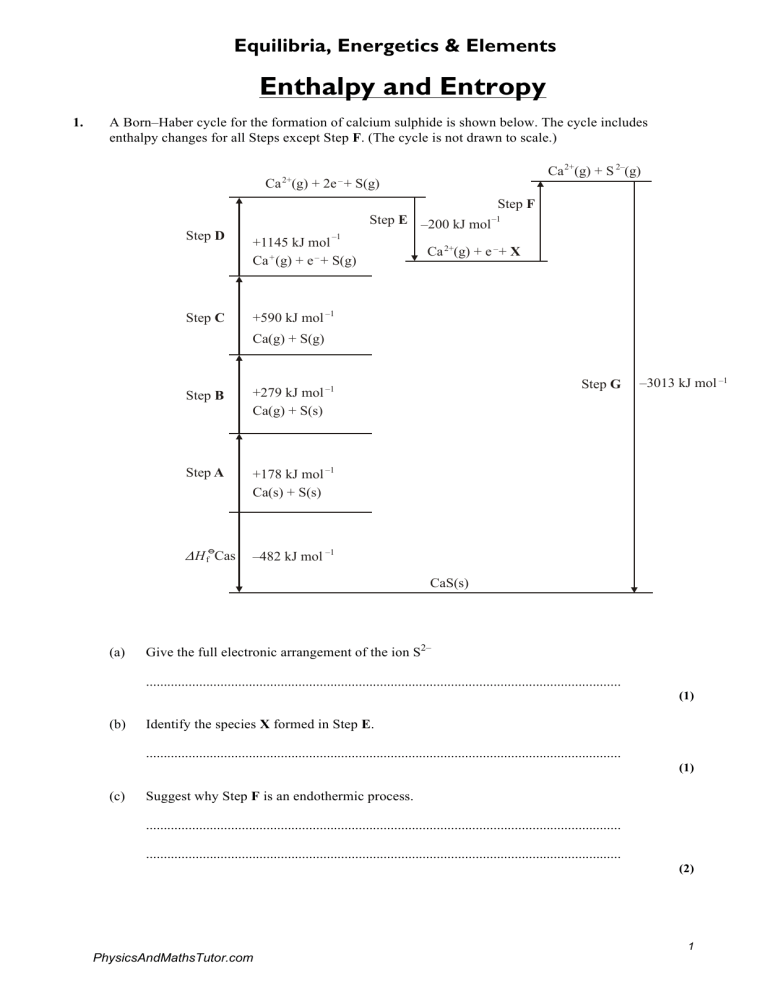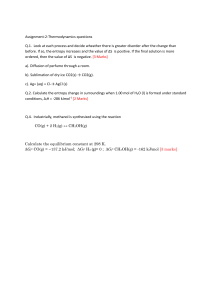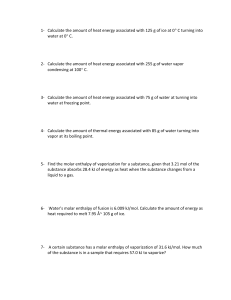
Equilibria, Energetics & Elements Enthalpy and Entropy 1. A Born–Haber cycle for the formation of calcium sulphide is shown below. The cycle includes enthalpy changes for all Steps except Step F. (The cycle is not drawn to scale.) 2+ Ca 2+(g) + S 2–(g) – Ca (g) + 2e + S(g) Step D Step C Step F Step E –200 kJ mol –1 –1 +1145 kJ mol Ca + (g) + e – + S(g) Ca 2+(g) + e – + X +590 kJ mol –1 Ca(g) + S(g) Step B +279 kJ mol –1 Ca(g) + S(s) Step A +178 kJ mol –1 Ca(s) + S(s) H f Cas Step G –3013 kJ mol –1 –482 kJ mol –1 CaS(s) (a) Give the full electronic arrangement of the ion S2– ...................................................................................................................................... (1) (b) Identify the species X formed in Step E. ...................................................................................................................................... (1) (c) Suggest why Step F is an endothermic process. ...................................................................................................................................... ...................................................................................................................................... (2) PhysicsAndMathsTutor.com 1 (d) Name the enthalpy change for each of the following steps. (i) Step B ............................................................................................................... (ii) Step D ............................................................................................................... (iii) Step F ................................................................................................................ (3) (e) Explain why the enthalpy change for Step D is larger than that for Step C. ...................................................................................................................................... ...................................................................................................................................... (2) (f) Use the data shown in the cycle to calculate a value for the enthalpy change for Step F. ...................................................................................................................................... ...................................................................................................................................... ...................................................................................................................................... (2) (Total 11 marks) 2. The energy level diagram (Born-Haber cycle) for caesium chloride is shown below. – Cs+(g) + Cl(g) + e ΔH4 = +121 kJ mol –1 ΔH5 = –364 kJ mol Cs+(g) + 12 Cl2(g) + e –1 – ΔH3 = +376 kJ mol –1 – Cs+(g) + Cl (g) Cs(g) + 12 Cl2(g) ΔH 2 = +79 kJ mol –1 ΔH 6 Cs(s) + 12 Cl 2 (g) ΔH1 = –433 kJ mol –1 CsCl(s) (a) Give the names of the enthalpy changes represented by ΔH1, ΔH2 and ΔH5. ΔH1 ........................................................................................................................... ΔH2 ........................................................................................................................... ΔH5 ........................................................................................................................... (3) PhysicsAndMathsTutor.com 2 (b) Calculate the value of the lattice energy ΔH6. (2) (c) Explain why the enthalpy change represented by ΔH3 has a lower magnitude for caesium than for sodium. ..................................................................................................................................... ..................................................................................................................................... ..................................................................................................................................... ..................................................................................................................................... (3) (Total 8 marks) 3. Figure 1 shows the energy level diagram (Born-Haber cycle) for the formation of rubidium iodide from its elements. ΔHI (Rb) = +402 kJ mol ΔH1 –1 – Rb+ (g) + I (g) Rb(g) + I(g) –1 ΔH at ( 12 I 2 ) = +107 kJ mol Rb(g) + 1 2 I 2 (s) ΔH at (Rb) = +85.8 kJ mol –1 ΔH 2 = –609 kJ mol ΔH f (RbI) = –328 kJ mol –1 –1 RbI(s) Figure 1 (i) Complete the diagram giving the identities of the missing species (2) (ii) Give the names of the enthalpy changes represented by ΔH1 and ΔH2. ΔH1 .................................................................................................................. PhysicsAndMathsTutor.com 3 ΔH2 .................................................................................................................. (2) (iii) Calculate the value of the enthalpy change represented by ΔH1. (2) (Total 6 marks) 4. The following data relate to lithium chloride. Standard molar enthalpy change of solution is –37.0 kJ mol–1. Lattice enthalpy is –846 kJ mol–1. + – Li (g) + Cl (g) Li(s) + ½Cl 2 (g) B Enthalpy C A LiCl(s) + – Li (aq) + Cl (aq) (i) Give the name of each of the changes A and B. A............................................... B............................................... (2) (ii) Calculate the value of the enthalpy change represented by C and suggest the name(s) of the enthalpy change(s). ......................................................................................................................... ......................................................................................................................... ......................................................................................................................... ......................................................................................................................... ......................................................................................................................... ......................................................................................................................... (3) (Total 5 marks) PhysicsAndMathsTutor.com 4 5. The sketch graph below shows how the entropy of a sample of water varies with temperature. Entropy 0 0 (a) T1 Temperature / K T2 Suggest why the entropy of water is zero at 0 K. ..................................................................................................................................... (1) (b) What change of state occurs at temperature T1? ..................................................................................................................................... (1) (c) Explain why the entropy change, ∆S, at temperature T2 is much larger than that at temperature T1. ..................................................................................................................................... ..................................................................................................................................... ..................................................................................................................................... (2) PhysicsAndMathsTutor.com 5 (d) It requires 3.49 kJ of heat energy to convert 1.53 g of liquid water into steam at 373 K and 100 kPa. (i) Use these data to calculate the enthalpy change, ∆H, when 1.00 mol of liquid water forms 1.00 mol of steam at 373 K and 100 kPa. ........................................................................................................................... ........................................................................................................................... ........................................................................................................................... ........................................................................................................................... (ii) Write an expression showing the relationship between free-energy change, ∆G, enthalpy change, ∆H, and entropy change, ∆S. ........................................................................................................................... (iii) For the conversion of liquid water into steam at 373 K and 100 kPa, ∆G = 0 kJ mol–1 Calculate the value of ∆S for the conversion of one mole of water into steam under these conditions. State the units. (If you have been unable to complete part (d)(i) you should assume that ∆H = 45.0 kJ mol–1. This is not the correct answer.) Calculation ....................................................................................................... ........................................................................................................................... ........................................................................................................................... Units ................................................................................................................. (6) (Total 10 marks) PhysicsAndMathsTutor.com 6 6. (a) (i) Draw a fully-labelled Born–Haber cycle for the formation of solid barium chloride, BaCl2, from its elements. Include state symbols for all species involved. (ii) Use your Born–Haber cycle and the standard enthalpy data given below to calculate a value for the electron affinity of chlorine. Enthalpy of atomisation of barium Enthalpy of atomisation of chlorine Enthalpy of formation of barium chloride First ionisation enthalpy of barium Second ionisation enthalpy of barium Lattice formation enthalpy of barium chloride +180 kJ mol–1 +122 kJ mol–1 –859 kJ mol–1 +503 kJ mol–1 +965 kJ mol–1 –2056 kJ mol–1 ........................................................................................................................... ........................................................................................................................... ........................................................................................................................... ........................................................................................................................... (9) PhysicsAndMathsTutor.com 7 (b) Use data from part (a)(ii) and the entropy data given below to calculate the lowest temperature at which the following reaction becomes feasible. BaCl2(s) → Ba(s) + Cl2(g) S BaCl2(s) Ba(s) Cl2(g) 124 63 223 / J K–1 mol–1 ..................................................................................................................................... ..................................................................................................................................... ..................................................................................................................................... ..................................................................................................................................... ..................................................................................................................................... (4) (Total 13 marks) 7. (a) The following reaction occurs in the high-temperature preparation of titanium(IV) chloride. TiO2(s) + C(s) + 2Cl2(g) → TiCl4(l) + CO2(g) (i) Use the data given below to calculate the standard enthalpy change and the standard entropy change for this reaction. Substance ΔHf / kJ mol–1 S / J K–1mol–1 TiO2(s) –940 49.9 C(s) 0 5.7 Cl2(g) TiCl4(l) CO2(g) 0 –804 –394 223 252 214 Standard enthalpy change ............................................................................ ..................................................................................................................... ..................................................................................................................... ..................................................................................................................... Standard entropy change ............................................................................. ..................................................................................................................... ..................................................................................................................... ..................................................................................................................... ..................................................................................................................... (ii) Calculate the temperature at which this reaction ceases to be feasible. ..................................................................................................................... ..................................................................................................................... (9) (Total 9 marks) PhysicsAndMathsTutor.com 8 8. Use the data in the table below to answer the questions which follow. (a) Substance Fe2O3(s) Fe(s) C(s) Co(g) CO2(g) ΔHf / kJ mol–1 –824.2 0 0 –110.5 –393.5 S / J K–1 mol–1 87.4 197.6 213.6 27.3 5.7 The following equation shows one of the reactions which can occur in the extraction of iron. Fe2O3(s) + 3CO(g) → 2Fe(s) + 3CO2(g) (i) Calculate the standard enthalpy change and the standard entropy change for this reaction. Standard enthalpy change ........................................................................... ...................................................................................................................... ...................................................................................................................... ...................................................................................................................... ...................................................................................................................... ...................................................................................................................... Standard entropy change ............................................................................. ...................................................................................................................... ...................................................................................................................... ...................................................................................................................... ...................................................................................................................... (ii) Explain why this reaction is feasible at all temperatures. ...................................................................................................................... ...................................................................................................................... ...................................................................................................................... (9) PhysicsAndMathsTutor.com 9 (b) The reaction shown by the following equation can also occur in the extraction of iron. Fe2O3(s) + 3C(s) → 2Fe(s) + 3CO(g) ΔH = +492.7 kJ mol–1 The standard entropy change, ΔS , for this reaction is +542.6 J K–1 mol–1 Use this information to calculate the temperature at which this reaction becomes feasible. ............................................................................................................................... ............................................................................................................................... ............................................................................................................................... (3) (c) Calculate the temperature at which the standard free-energy change, ΔG value for the reactions in parts (a) and (b). has the same ............................................................................................................................... ............................................................................................................................... ............................................................................................................................... ............................................................................................................................... (3) (Total 15 marks) 9. Hydrogen used in the manufacture of ammonia is produced by the reaction between methane and steam shown in the following equation. CH4(g) + 2H2O(g) CO2(g) + 4H2(g) Use the data given below to answer the questions which follow. (a) CH 4 (g) H 2 O(g) CO 2 (g) H 2 (g) ΔHf /kJ mol–1 –74.8 –241.8 –393.5 0 S /J K–1 mol –1 186.2 188.7 213.6 130.6 Calculate the standard enthalpy change, ΔH , for this reaction. .................................................................................................................................... .................................................................................................................................... .................................................................................................................................... .................................................................................................................................... (3) PhysicsAndMathsTutor.com 10 (b) (i) Explain, in terms of disorder, why entropy increases in this reaction. ........................................................................................................................... ........................................................................................................................... (ii) Calculate the standard entropy change for this reaction. ........................................................................................................................... ........................................................................................................................... ........................................................................................................................... (5) (c) (i) Calculate the temperature at which the free-energy change, ΔG, for the above reaction is zero. (Assume that ΔH and ΔS do not vary with temperature.) ........................................................................................................................... ........................................................................................................................... ........................................................................................................................... (ii) What is the significance of this temperature? ........................................................................................................................... ........................................................................................................................... (5) (Total 13 marks) PhysicsAndMathsTutor.com 11 10. Methanol can be synthesised from carbon monoxide and hydrogen according to the equation CO(g) + 2H2(g) CH3OH(g) Use the thermodynamic data below to answer the questions that follow. Substance (a) ΔH /kJ mol–1 S / J K–1 mol–1 CO(g) –110 198 H2(g) 0 131 CH3OH(g) –201 240 Determine the standard enthalpy change and the standard entropy change for the synthesis of methanol from carbon monoxide and hydrogen. ΔH .......................................................................................................................... ..................................................................................................................................... ..................................................................................................................................... ..................................................................................................................................... ΔS ............................................................................................................................. ..................................................................................................................................... ..................................................................................................................................... ..................................................................................................................................... (4) (b) Explain what is meant by the term feasible reaction and determine the temperature at which the methanol synthesis reaction is no longer feasible. Feasible reaction.......................................................................................................... ..................................................................................................................................... Temperature................................................................................................................. ..................................................................................................................................... (3) (Total 7 marks) PhysicsAndMathsTutor.com 12 11. Sulphur dioxide reacts with oxygen to form sulphur trioxide according to the equation 2SO2(g) + O2(g) 2SO3(g) Data for this reaction are shown in the table below. SO3(g) SO2(g) O2(g) (a) ΔH /kJ mol–1 S /J K–1 mol –1 –396 –297 0 +257 +248 +204 Determine the standard enthalpy, the standard entropy and standard free energy changes at 298 K for this reaction. ΔH 298 ....................................................................................................................... .................................................................................................................................... .................................................................................................................................... .................................................................................................................................... ΔS 298 .......................................................................................................................... .................................................................................................................................... .................................................................................................................................... .................................................................................................................................... ΔG 298 .......................................................................................................................... .................................................................................................................................... .................................................................................................................................... .................................................................................................................................... (7) PhysicsAndMathsTutor.com 13 (b) The reaction is said to be feasible. In terms of free energy change, explain the meaning of the term feasible. Calculate the temperature at which the reaction between sulphur dioxide and oxygen ceases to be feasible. Feasible reaction........................................................................................................ Temperature................................................................................................................ .................................................................................................................................... .................................................................................................................................... .................................................................................................................................... (3) (Total 10 marks) 12. Sulphuric acid is manufactured by the Contact Process. One stage of the process is the oxidation of sulphur dioxide according to the equation: 2SO2(g) + O2(g) 2SO3(g) ΔH = –196 kJ mol–1 Typical operating conditions are a temperature of about 450 °C, close to atmospheric pressure and the presence of a catalyst. The use of a converter containing four catalyst beds results in a 99.5% conversion. The value of the entropy change, ΔS, for the reaction between sulphur dioxide and oxygen –188 J mol–1 K–1. (i) Explain why there is a decrease in entropy of the system. ........................................................................................................................... ........................................................................................................................... ........................................................................................................................... (2) (ii) Use the equation ΔG = ΔH – TΔS to calculate the value of ΔG for the reaction between sulphur dioxide and oxygen at 25 °C. Explain the significance of the sign of the value obtained. Calculation Explanation ....................................................................................................... ........................................................................................................................... (4) (Total 6 marks) PhysicsAndMathsTutor.com 14 13. (a) (i) Construct a Born-Haber cycle for the formation of calcium chloride, CaCl2, from its elements. Name each step in the cycle and mark on the cycle each species involved together with its state symbol. (ii) When calcium reacts with chlorine under normal laboratory conditions CaC12 is formed not CaCl. Identify the stages in the Born-Haber cycle for the formation of CaCl which differ from those in the cycle for the formation of CaC12 (11) (b) (i) Use the data given below to calculate the standard enthalpy of solution of CaCl2. Lattice dissociation enthalpy of CaCl2 = +2255 kJ mol–1 Hydration enthalpy of calcium ions Hydration enthalpy of chloride ions (ii) = –1650 kJ mol–1 = –384 kJ mol–1 Using your answer to part (b)(i), deduce how the solubility of CaCl2 changes as temperature is increased. Explain your answer. (6) (Total 17 marks) PhysicsAndMathsTutor.com 15 14. Construct a Born-Haber cycle for the formation of the hypothetical crystalline solid magnesium(I) chloride, MgCl(s). The table below shows values of standard enthalpies for some processes involving magnesium and chlorine. Use these values to calculate the standard enthalpy of formation of the hypothetical MgCl(s). Use your answer to calculate the standard enthalpy change for the reaction 2MgCl(s) MgCl2(s) + Mg(s) given that the standard enthalpy of formation of MgCl2(s), ΔH , is –653 kJ mol–1 Explain why the standard entropy change in this reaction is likely to be negligibly small. Comment on the stability of MgCl(s) relative to that of MgCl2(s). ΔH kJ mol–1 Mg+(g) + Cl–(g) → MgCl(s) –753 Cl(g) + e – → Cl–(g) -364 → Cl(g) +121 Mg(s) → Μg(g) +146 Μg(s) → Mg+(g) + e- +736______ 1 2 Cl2 (g) PhysicsAndMathsTutor.com (Total 10 marks) 16 15. (a) State what is meant by the term enthalpy change. (2) (b) (c) Construct a fully-labelled Born-Haber cycle for the formation of MgO and use the data given below to calculate a value for the enthalpy of lattice formation of this oxide. Process Mg(s) + 12 O2(g) → MgO(s) Mg(s) → Mg(g) Mg(g) → Mg+(g) + e– Mg+(g) → Mg2+(g) + e– O2(g) → 2O(g) ΔH /kJ mol–1 –602 +148 +738 +1451 +498 O(g) + e– → O–(g) O–(g) + e– → O2–(g) –141 +798 (8) By consideration of the entropy changes in the reaction and the data given below, explain why the following reaction is never feasible. 1 2 MgCl2(s) + Cl2(g) → MgCl3(s) ΔH / kJ mol–1 –653 +3904 Compound MgCl2(s) MgCl3(s) (5) (Total 15 marks) 16. Ethyl ethanoate can be prepared by the reactions shown below. Reaction 1 CH3COOH(l) + C2H5OH(l) CH3COOC2H5(l) + H2O(l) Reaction 2 CH3COCl(l) + C2H5OH(l) → CH3COOC2H5(l) + HCl(g) ΔH ΔH –1 = –2.0 kJ mol –1 = –21.6 kJ mol Use the information given above and the data below to calculate values for the standard entropy change, ΔS , and the standard free-energy change, ΔG , for Reaction 2 at 298 K. CH3COCl(l) C2H5OH(l) CH3COOC2H5(l) HCl(g) 201 161 259 187 (6) (Total 6 marks) PhysicsAndMathsTutor.com 17 17. The equations for two industrial equilibrium reactions are given below. Reaction 1 CH4(g) + H2O(g) Reaction 2 N2(g) + 3H2(g) (a) CO(g) + 3H2(g) 2NH3(g) Use the information in the table below to calculate the temperatures at which the free-energy change for each reaction is equal to zero. CH 4 (g) H 2 O(g) CO(g) H 2 (g) N 2(g) NH 2 (g) –1 –74.8 –241.8 –110.5 0 0 –46.1 S /J K –1 mol –1 186.2 188.7 197.6 130.6 191.6 192.3 ΔH f /kJ mol (10) (b) In industry, Reaction 1 and Reaction 2 are carried out at high temperatures. State how, using temperatures higher than those calculated in part (a), the yields of products are altered in Reaction 1 and in Reaction 2. In each case, explain why a high temperature is used in practice. (5) (Total 15 marks) PhysicsAndMathsTutor.com 18 18. (a) The reaction given below does not occur at room temperature. CO2(g) + C(s) → 2CO(g) Use the data given below to calculate the lowest temperature at which this reaction becomes feasible. C(s) CO(g) CO2(g) ΔH /kJ mol–1 0 –110.5 –393.5 S /J K–1 mol–1 5.7 197.6 213.6 (8) (b) When an electrical heating coil was used to supply 3675 J of energy to a sample of water which was boiling at 373 K, 1.50 g water were vaporised. Use this information to calculate the entropy change for the process H2O(l) → H2O(g) (3) (Total 11 marks) 19. Iron (II) oxide can be reduced to iron both by carbon, which is oxidised to carbon monoxide, and by carbon monoxide, which is oxidised to carbon dioxide, as shown in the equations below. FeO(s) + C(s) → Fe(s) + CO(g) FeO(s) + CO(g) → Fe(s) + CO2(g) (a) Use the data given below to deduce the free energy change, ΔG , measured at 450 K, for each of these reduction processes. (Assume that the enthalpy change and the entropy change in each of these reactions remain the same if the temperature is raised from 298 K to 450 K.) FeO(s) Fe(s) C(s) CO(g) CO2(g) ΔH /kJ mol–1 –271.9 0 0 –110.5 -393.5 S /J K–1 mol–1 58.5 27.3 5.7 197.6 213.6 (10) (b) Deduce how an increase in temperature will affect the feasibility of each of the processes in which iron(II) oxide is reduced to iron. (5) (Total 15 marks) PhysicsAndMathsTutor.com 19





